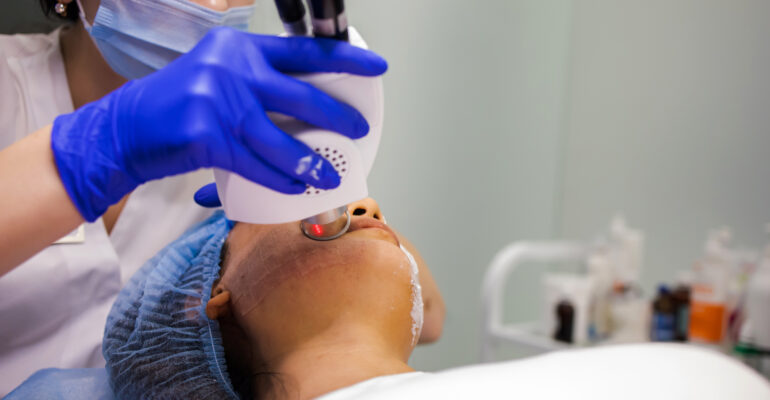The Cost Of Clear Skin: Breaking Down The Acne Scar Removal Procedure
November 15, 2023 2023-11-15 8:28The Cost Of Clear Skin: Breaking Down The Acne Scar Removal Procedure
As an Amazon associate, Dermatocare earns from valid purchase made by clicking on the affiliate links in this blog.

The Cost Of Clear Skin: Breaking Down The Acne Scar Removal Procedure
Acne scars often carry more than a physical mark; they can be a source of decreased confidence and heightened self-consciousness. Many, in their quest for clear skin, explore various treatments that promise a renewed complexion. However, it’s essential to understand the nuances of acne scars and the available options before diving into these treatments.
This article dives into acne scar removal techniques, addressing the costs and other vital considerations. For those overwhelmed by the plethora of information, it offers clarity to assist in making an informed decision.
Understanding Acne Scars
Acne scars are the persistent after-effects of severe acne breakouts. When the skin experiences trauma, either from inflamed pimples, cysts, or external picking and prodding, it reacts by producing or reducing collagen. This imbalance during the healing process can lead to uneven skin texture and tone, manifesting as scars.

There are several types of acne scars, each with its unique appearance and underlying cause:
- Ice pick scars – These are deep, narrow scars that penetrate the dermis. They resemble a puncture or small hole akin to the mark an ice pick would leave.
- Boxcar scars – These scars are broad with sharp edges, giving the skin a pitted appearance. They often form when an inflamed breakout damages the skin’s collagen, leading to tissue loss.
- Rolling scars – Characterized by their wavy texture, rolling scars make the skin appear uneven and rough. They arise due to fibrous bands between the skin and the underlying tissue that pull the epidermis into a deeper structure, leading to an undulating skin surface.
- Hypertrophic scars – Unlike the scars mentioned earlier, hypertrophic scars rise above the skin’s surface. They develop due to an overproduction of collagen during the healing process.
Recognizing the specific type of acne mark is crucial in determining the most suitable treatment. Each lesion presents its own set of challenges. What might be effective for one type could be less so for another.
Choosing the right treatment also involves being aware of the costs involved. By understanding the various scar types and researching the acne scar removal price of their go-to clinic, individuals can make well-informed decisions that suit their specific needs and budget.
Common Acne Scar Removal Techniques
Attaining clearer skin, free from acne blemishes, requires exploring various treatment options. Each technique has unique strengths, tailored for specific types and individual preferences. It’s time to explore some of the widely recognized methods:
- Chemical peels – This procedure entails applying an acid solution to the skin, prompting the exfoliation of its outer layer, which then peels off, revealing a more refined layer beneath. Depending on the mark’s depth and the desired results, the intensity of the peel can vary from light to intense.
- Dermabrasion and microdermabrasion – These techniques, both aimed at enhancing the skin’s surface layers, offer unique approaches and outcomes. Dermabrasion involves using a specialized instrument to meticulously “sand” the skin. It’s particularly effective for treating deeper scars, though it comes with a lengthier recovery time. Microdermabrasion, a gentler procedure, utilizes fine crystals sprayed onto the skin for exfoliation. Ideally suited for addressing superficial scars, it boasts a shorter recovery duration.
- Laser resurfacing – This method harnesses targeted laser beams to shed the skin’s outer layer while promoting collagen synthesis in the layers below. Leading clinics like Sozo categorize their laser offerings into two main types: ablative and non-ablative. Ablative lasers focus on removing outer skin layers, offering pronounced results at the cost of an extended recovery time. In contrast, non-ablative lasers encourage collagen production without skin removal, providing faster recovery but requiring more treatment sessions.
- Fillers – Fillers elevate depressed scar areas by injecting collagen, hyaluronic acid, or even fat, aligning them with the surrounding skin’s level.
- Microneedling – In this procedure, a roller embedded with fine needles punctures the skin minutely, igniting collagen production. This organic healing process incrementally refines skin texture, lessening scar visibility. You typically need multiple sessions to see noticeable results.
- Punch Techniques – Tailored for more profound scars, especially those resembling ice pick indentations, this surgical approach encompasses three main procedures: punch excision, punch elevation, and punch grafting. In punch excision, the surgeon removes the scar and sutures the resulting void. In punch elevation, the surgeon raises the scar’s base to match the level of the surrounding skin, reducing its depth. Punch grafting, on the other hand, replaces the scar tissue with a skin graft, typically harvested from behind the ear.
When selecting the proper technique, seeking professional advice is invaluable. It’s essential to consider the nature of the scar, desired outcomes, financial aspects, and the potential risks and side effects associated with each procedure. Given the variety of options available, achieving smoother, scar-reduced skin is a realistic goal for many.
Factors Affecting The Cost Of Acne Scar Removal
When considering acne scar removal, understanding the various factors influencing the cost is essential. The price tag attached to these treatments can differ substantially based on several elements:
- Type of treatment – As discussed earlier, there’s a wide array of procedures available, each with its pricing structure. For instance, laser resurfacing might be more expensive than chemical peels due to the advanced technology.
- Severity and extent of scarring – More extensive or severe scarring might necessitate multiple sessions or a combination of treatments, increasing the overall cost.
- Geographic location –The clinic’s location can significantly affect costs. Metropolitan areas with higher living standards charge more than clinics in smaller towns or regions.
- Clinic’s reputation and expertise – A well-renowned clinic or a dermatologist with a stellar reputation might have higher fees, reflecting their expertise and experience.
- Equipment and technology – The latest state-of-the-art equipment might drive up costs. However, they might also offer better results, reducing the need for multiple sessions.
- Additional costs: These can include consultation fees, post-treatment care products, or any follow-up visits required.
- Customization – Personalized treatment plans tailored to an individual’s needs might cost more than standard, one-size-fits-all procedures.
It’s essential to remember that while cost is a significant consideration, the quality of treatment, safety, and potential results should also play a central role in the decision-making process. A transparent discussion with the dermatologist or clinic about all costs involved can help in making an informed choice.
Additional Costs To Consider
While the primary treatment costs might be straightforward, there are often additional expenses related to acne scar removal that patients should know of. These can sometimes be overlooked but can add up, influencing the total investment in the quest for clear skin:
- Consultation fees – While some clinics offer complimentary initial consultations, others might charge for this service. It’s an essential step to determine the best treatment route and gauge compatibility with a provider.
- Pre-treatment preparations – The recommended procedure might require using specific skin care products or medications before the treatment, incurring additional costs to prepare the skin and guarantee the best results.
- Post-treatment care – After a procedure, a dermatologist or skincare specialist may prescribe certain skincare products or medications to support recovery, ease discomfort, and improve results. These prescriptions might consist of moisturizers, sunscreens, or topical antibiotics.
- Follow-up visits – Some treatments might require periodic check-ins with the dermatologist or skincare specialist to monitor healing and results. Depending on the clinic’s policy, there might be charges for these visits.
- Anesthesia or sedation –For more invasive procedures, a practitioner may administer local or general anesthesia, which adds to the cost.
- Facility fees – Some treatments might be carried out in specialized facilities or surgical centers, leading to separate charges for room usage and equipment.
- Potential complications –While rare, problems can arise that require additional treatments or medications, increasing the overall expense.
- Maintenance treatments – To maintain or enhance results, periodic touch-ups or maintenance sessions might be recommended, especially for treatments like fillers or microdermabrasion.
When budgeting for acne scar removal, it’s crucial to take a holistic view of all potential expenses. An open dialogue with the clinic or dermatologist about these additional costs will ensure no surprises and allow for adequate financial preparation.
Financing And Insurance Considerations
Exploring the financial aspects of acne scar removal can be as crucial as understanding the procedures. Here are some key considerations regarding financing and insurance:
- Medical insurance – Standard health insurance policies typically don’t cover acne scar removal treatments because they consider them cosmetic. However, if scarring causes health issues, such as persistent pain or emotional distress, there might be a possibility for partial coverage. It’s essential to review your policy and discuss it with your insurance provider.
- Clinic payment plans – Many clinics recognize the financial strain that these treatments can impose. To ease this, they might offer monthly payment plans or financing options, allowing patients to distribute the overall cost into more manageable monthly installments.
- Medical credit cards – Some credit cards are specifically designed for healthcare expenses, offering promotional interest rates or extended payment terms. But be cautious and understand the terms, as interest rates can skyrocket after promotional periods.
- Personal loans – Some individuals opt for personal loans to finance their treatments. While they can offer fixed interest rates and fixed monthly payments, it’s crucial to shop around and find the best terms.
- Health Savings Accounts (HSAs) and Flexible Spending Accounts (FSAs) – Depending on where you live and your employment benefits, you might have access to HSAs or FSAs. These accounts allow you to set aside pre-tax dollars for medical expenses. While cosmetic procedures often aren’t eligible, it’s worth checking the specifics of your account.
Remember, clear communication with your treatment provider and potential financiers is essential. Before committing to any financial decision, ensure you know all costs, interest rates, and terms. It’s also worth noting that some financial options, especially loans or credit cards, may require a good credit score. Investing in your skin is a significant step, and having a comprehensive understanding of the financial aspects can help streamline the process and set clear expectations.
Final Thoughts
The path to rejuvenated, scar-free skin is personal and transformative. Each stride forward refines one’s appearance and significantly elevates confidence and self-worth. As you contemplate this pivotal decision, remember that well-informed choices yield the most rewarding outcomes. In this course, it’s paramount to prioritize your well-being and rely on professional expertise. Ready to move forward? Embrace the radiant beauty that lies ahead.
ROUTINE FINDER
Get free dermatologist-recommended regime by choosing your skin or concerns.

FACE

HAIRS

CHILD

BODY




